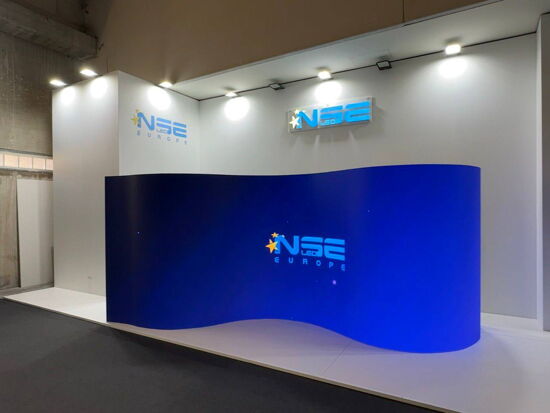The print paradox: why should you use white ink?

The topic of white ink has caused some disagreement in traditional commercial printing. However, many digital printing applications would not be possible without it. Sonja Angerer details the benefits of white ink and its most valuable applications.
Today, entry level digital printing is often equipped with channels for white ink. In this article, we will discuss what makes these systems special.
- What sets apart white ink, from other inkjet kits?
- The well-known digital printing applications that would not be possible without white ink
- Advantages and disadvantages of the technology
 Caption: HP introduced white printing with latex inks with the 2018 R-series. Photo: HP
Caption: HP introduced white printing with latex inks with the 2018 R-series. Photo: HPWhat to know about white ink
This means that white ink can only be used in certified print heads. The earliest inkjet printers with UV-curable white ink were introduced into the Europe market in 2000. The Durst Rho 160 W Plus, which was launched in 2004 was likely the first model by a well-known manufacturer.
After which the technology quickly spread throughout the industry: “In 2006 we introduced white ink as part of the Uvijet EI Colour Range for the Inca Columbia Turbo machine”, explains Kevin Jenner, European Marketing Manager at Fujifilm Wide Format Inkjet Systems.
The market has also been hit with water-based systems for proof printing, using white inks such as the Epson Pro WT7900 (2010). Today, water-based white inks are only ever used for direct printing on dark and coloured T-shirts (DTG).
In 2018, HP introduced the R-series, they are considered the first latex printer with optional white inks.
 Caption: White ink a required for printing on dark textiles. Photo: S. Angerer
Caption: White ink a required for printing on dark textiles. Photo: S. AngererWhite ink: advantages and disadvantages
Using white ink: what to know
Common uses for white ink are:
- printing on full-surface coloured substrates (e.g. coloured film, corrugated, cardboard)
- backlit prints on transparent film (city light posters, day/night, window film)
- direct print textile printing on coloured or dark textiles
- barrier on metallic foil in packaging printing
- DTF print
Problems with white ink in inkjet printing
“Getting the correct particle size to create a clean white colour is a significant technical challenge. It is also difficult to jet through the nozzle without causing blockages or settling within the print system”, explains Jenner.
However, it is important that white ink is stirred up regularly to prevent sedimentation. This can cause grave damage at ink-carrying parts and print heads and can also reduce the print quality considerably.
Therefore, print heads for white ink in printers need to be flushed out, this is usually done automatically. However, this can cause ink to be lost and in some extreme cases, can lead to a cartridge of white ink to run out before a job has been printed. Due to this, printers temporarily or permanently deactivate white ink. Some also choose different ink configurations when printing a second time round and when making replacement purchases.
Printers with a screen and digital printing business can also apply a white screen printing base layer for larger orders. Since white ink for inkjet printers can be significantly more expensive than screen printing ink, some applications can be achieved through a combination of analogue and digital printing, making it more cost-effective.
 Caption: Digital printers from EFI offer many ways to achieve spectacular effects with white inks Pictured: Part of a presentation by Stacy Keenan at EFI Connect.
Caption: Digital printers from EFI offer many ways to achieve spectacular effects with white inks Pictured: Part of a presentation by Stacy Keenan at EFI Connect.
The future of white ink
There are many standard inkjet applications that would not be possible without white inks. Therefore, we can predict that in the future there will be an increase in the production systems that are already equipped with white ink.
The new DTF technology for printing on T-shirts and other garments should give an extra boost to white ink, as white ink is an essential factor.
However, in the current increase in raw material, waste management and energy costs, printers are likely choose presses offering white and metallic printing. Or a clear overcoat in the future but only if they expect a significant number of relevant jobs.
Main Image caption: Without white ink, City Light Posters (in picture: a Duisburg CLP by Ströer) could not be printed digitally. Photo: Ströer
Topics
Interested in joining our community?
Enquire today about joining your local FESPA Association or FESPA Direct
Recent news
.png?width=550)
Why are FESPA events the ideal place for visionaries to meet? With Harold Klaren from EFKA
We speak to Harold Klaren, International Sales Manager at EFKA about visionaries in print. Harold shares why he believes FESPA events are the ideal place for visionareis to meet.

NSELED to showcase Innovation and transformation at European Sign Expo 2025
NSELED Europe, part of leading LED display technology provider NSE, will welcome visitors to its stand at the European Sign Expo 2025. Ahead of the event, we speak with Daniele Rocca, principal chief executive officer at NSELED Europe, about what to expect from the company as the official ‘Digital Screen Partner’ of the event.

Why the Future of Print Is Personal – and What That Means for Your Business
Minna Philipson, CMO at Gelato shares how the future of print is personal, driven by demands for tailored, localised, and on-demand products. Businesses must adapt, embracing software to streamline operations and building customer-centric brands. Personalisation is key to connection, requiring emotional storytelling and flexible operations to thrive in the evolving market.

The latest sustainable solutions in non-digital signage
While by no means a new concept in the market, sustainability is becoming an increasingly important part of daily life for sign-making businesses. Here, Rob Fletcher shares some of the non-digital materials to help companies become more planet friendly.